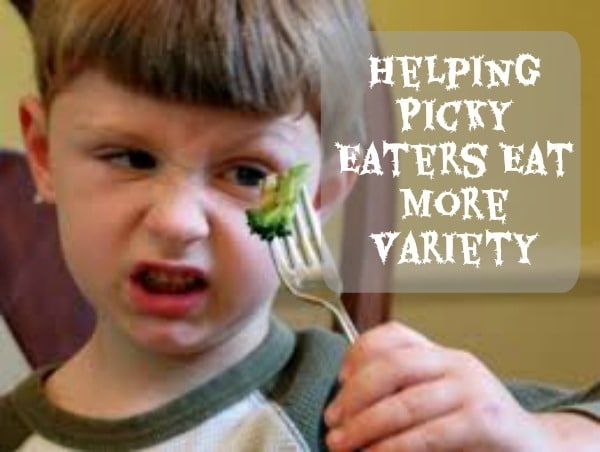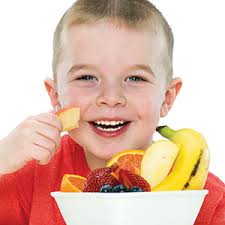 Shauna @ Our Times is guest posting today for the Establish a House series. I am so glad she was willing to tackle this subject and give us some tips she has used with her own children! Be sure to leave your own tips and suggestions in the comments.
Shauna @ Our Times is guest posting today for the Establish a House series. I am so glad she was willing to tackle this subject and give us some tips she has used with her own children! Be sure to leave your own tips and suggestions in the comments.
Hello friends! I am going to attempt to help you help your children to eat a greater variety of food. If your kids are like mine, vegetable consumption is where we struggle most, but the following principles apply to all types of healthful food. Lest you think my home is a shining example of well-behaved and happily satiated children around the dinner table, I feel it only right to tell you that these guidelines are not my own genius, but found in the book French Kids Eat Everything by Karen Le Billon, a Canadian woman who married a Frenchman. She, her husband, and two daughters moved to her husband’s hometown for a year where she saw firsthand how French children are wonderful eaters, so she wrote a book to share her experience and what she learned. As I read the book a year or two ago, I can not recall all the suggestions; I believe there were ten of them. But I will share with you what I remember as well as throw in a thing or two that works for myself and my family. I hope something is helpful to you!
 #1 – Feed them vegetables first. Starting with babies, here’s an idea of my own: when starting your baby on solid foods, start with veggies first, not grains. Hopefully this will help your little one to develop a palate for vegetables. I’ve found that kids start rejecting foods around 18 months-two years, but I believe/hope that if they were started on vegetables and other real foods, they will return to it again someday.
#1 – Feed them vegetables first. Starting with babies, here’s an idea of my own: when starting your baby on solid foods, start with veggies first, not grains. Hopefully this will help your little one to develop a palate for vegetables. I’ve found that kids start rejecting foods around 18 months-two years, but I believe/hope that if they were started on vegetables and other real foods, they will return to it again someday.
#2 – Don’t make separate meals/foods for your children. I recall a time my sister-in-law and I were talking about feeding children. She told me of her experience while serving a mission in Korea, where she saw children eating all sorts of vegetables and hot, spicy foods. She asked a mother how she got her children to eat that way and the mother replied with a confused expression, “It’s just what we eat. The kids eat what we eat.” So starting from when baby is beginning solids, I adapt whatever we are eating to fit the baby’s needs (steam or make foods soft and squishy enough for baby to eat), but I don’t make a different dish for the baby.
#3 – Let children plan and prepare meals. I have one son, currently three, who is my best helper in the kitchen, especially at the griddle. He can cook (flip) tortillas all by himself. All my children love to stand at the counter with me and help make food, and while it is annoying to me sometimes because I like to move quickly and get things done, it hardly takes more time, just a little more observation on my part to help them learn how to do things. When kids are able to help choose and prepare the food they consume, it gives them a sense of ownership and responsibility and will make it much more likely that they will actually eat the food. And then we as parents get to teach them good eating habits along the way.
#4 – Eat a good variety of real food. Good eating habits includes eating a variety of foods. We’ve all heard/read things like try to eat all the colors of the rainbow daily, or eat mostly vegetables, along with a healthful balance of whole grains, fruits, and proteins. I have some strong granola tendencies, so I try to help my family eat real food (not processed or packaged) that is in season or preserved wisely, and that is mostly local. And I find that my eating is very fluid. I used to think 5-7 years ago that I had “arrived,” meaning my eating habits were established and there wasn’t much more I could learn or change, but that has not been the case at all. So I’m now looking forward to what I’ll learn and change in the coming years.
#5 – If at first you don’t succeed, try 20 more times. With all this attempt at eating a variety of food, there will be a lot of rejection by your children, perhaps your husband, and possibly yourself. When I look back at my eating habits in my parent’s house, and then when I was first married, my diet included a LOT of packaged food. Over the years I’ve had to change my palate as I’ve introduced real food. My like of sweetened food is diminishing, but please don’t mistake me. I love a really good dessert as much as the next person. I’ve recently started baking with natural yeast instead of active-dry yeast, which has a more sour flavor to it. I didn’t care for the sourness in the beginning, but believed that baking with natural yeast is more healthful for me and my family, so kept at it and now I hardly even taste the sourness. My kids are the same. They didn’t like my new bread at first, and now they love it. They still struggle with some of the natural yeast things I make, but it’s a work in progress. The principle here is that your children will have to try things over and over and over and over before liking them. I can not recall the exact number she gave in French Kids Eat Everything, but I believe the number of times a child may have to try a new food before liking it was in the teens to low 20s. So don’t get discouraged. Just keep inviting children to eat healthful foods in different ways and they will eventually catch on. Just tonight my eldest said that she liked broccolini and asparagus. Wahoo! She has also learned to like salmon and chicken, whereas in times past she hasn’t eaten any meat at all.
#s 6 & 7 – The “try it” bite and earning desserts. I’m going to combine two principles into one paragraph here: requiring one try-it bite and how to earn dessert, if dessert is being served. First, the try-it bite. I’m sure many of you have already established this one. Sometimes I think it’s all for naught because I see that my children are so determined to not like the food presented that one bite will not convince them that they can like it. With my older children (4-5 years and up), I often require them eating as many bites as their age, depending on their level of dislike of the food. But if there is a dessert, they must eat the portion that is served them if they want to have dessert. Sometimes this is enough motivation, sometimes not. But the choice and consequences lies with the child, and that in itself is a good lesson.
#8 – Prepare edible options. One principle from the book that has saved me is to always serve at least two foods that your children will eat, so that they don’t go hungry. The author related a very funny story about the first time she started revolutionizing the way they ate and how the dinner she made didn’t include any food that her daughters liked. Lots of tears and frustration ensued. She learned that there is wisdom in having some dishes that they kids can eat, but not letting them fill up on only those things that they like. So sometimes my children are a little hungry by the end of dinnertime if they don’t eat the required servings of all the dishes available, but they are not so uncomfortably hungry that they are falling apart.
#9 – An eating scheduled. “Hunger is the best sauce/spice,” so it’s said, and having scheduled eating times can be very helpful in encouraging your children to eat what they are given. French culture is especially strict about this, so much so that they have ads against snacking like we do against smoking!!! According to Ms. Le Billon, the French eat breakfast at 7:30 am, lunch at 12:30, children may have a snack at 4:30, and then dinner at 7:30 pm. My family does not follow this schedule, and actually our eating schedule changes throughout the year depending on when the kids are in school. The point of the schedule is to help children know there are certain times to eat so that they will eat what is given and hopefully fill their tummies. My six-year old daughter can really struggle with this. She so enjoys playing and moving around that sitting down and eating until she is full is hard for her to do. But when she is hungry, she is beastly, so miserable to be around. It’s a tricky balance to find, when to let her have a little something to eat so she’s not so unpleasant and unhappy, and when to stick to my guns and say, “Wait until the next eating time.” This principle has been one of my favorites to adapt into our lives, though. We rarely eat while driving around, which makes for much less mess, and my kids are now used to it so not bothering me for food all the time.
#10 – Presentation! I also remember that presentation can go a long ways. The author recommended having a nice table setting to have a sort of “fancy” effect. That way, the kids can feel like it’s an important occasion, and maybe even be well-behaved! I stink at presenting food in an aesthetically-pleasing manner, but my husband is great at it. I should have him put the meals together and then give them to the kids. I’ve also seen plates with faces on them and you arrange the food on and around the face for hair, eyes, etc. so it’s a fun thing for children to eat.
#11 – Remember and relate. One last suggestion of my own: it’s helpful for me to remember what I didn’t like as a kid so I can relate to my children easier. For example, two things I really did not like were coconut and sour dough breads. My oldest daughter, who is the most similar to me, also does not like these flavors, and that’s all right. I lost enough taste buds over the years, and my palate changed so that I love these flavors now. Did you know that kids have 100% of their taste buds but we lose them as we age? So some things that may not have a powerful taste for us can be overwhelming for children.
There is all my eating wisdom for you. Good luck to you on your endeavor to help your children enjoy all sorts of good foods out there. And have fun on your eating adventures!
 Shauna is a native Northwesterner who loves to dance, trail run, and have babies, as she is about to have her fifth. And all things dark chocolate, especially Amano. Yum! Reading while eating an enormous bowl of popcorn is another favorite pastime of hers. She believes that tickling her children daily is good for everyone’s health. One day she aspires to own chickens and goats, an orchard, and a large garden. Right now she has a very large dirt field with a lot of potential. She and her family love to watch the local fauna, especially the squirrel family living under their storage shed, and the elusive rabbit in their front yard whom they have dubbed Fletcher. You can visit Shauna’s family blog at ourtimes1982.blogspot.com or her personal and often neglected blog at thatiswhatithinkpnw.blogspot.com.
Shauna is a native Northwesterner who loves to dance, trail run, and have babies, as she is about to have her fifth. And all things dark chocolate, especially Amano. Yum! Reading while eating an enormous bowl of popcorn is another favorite pastime of hers. She believes that tickling her children daily is good for everyone’s health. One day she aspires to own chickens and goats, an orchard, and a large garden. Right now she has a very large dirt field with a lot of potential. She and her family love to watch the local fauna, especially the squirrel family living under their storage shed, and the elusive rabbit in their front yard whom they have dubbed Fletcher. You can visit Shauna’s family blog at ourtimes1982.blogspot.com or her personal and often neglected blog at thatiswhatithinkpnw.blogspot.com.





I wrote a post about this once upon a time. Here’s the linky if anyone is interested: http://www.latter-dayhomeschooling.com/2014/04/catch-excitement.html.
Great post. One thing to watch out for in a child who really doesn’t like something is food allergies. Sometimes kids don’t like the taste and/or smell of something they are allergic to.